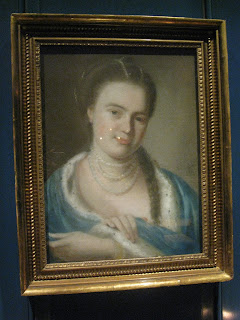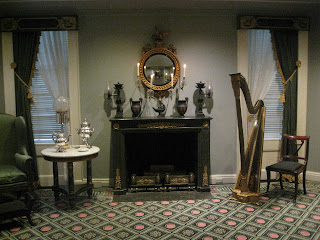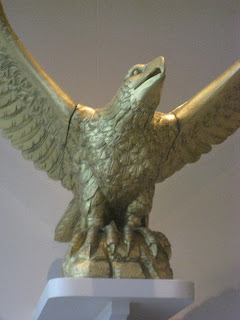Early 19th century Federal room at the Bayou Bend Collection and Gardens
The last weekend of September I was invited to Texas for a long weekend by a friend to show my Folk artwork at the Smither Park Grand Opening Celebration. Houston's first folk art-inspired green space, dedicated to Stephanie and John Smither, avid and celebrated collectors of visionary and self-taught art. Smither Park took six years and nearly 300 artists to complete, and is a public mosaic masterpiece. We had a wonderful time! This was the first time I step foot on Texas soil other then the airport going to France!
At the end of the weekend it was time to get some museums in and some antiquing! Bayou Bend Collection and Gardens was 1st on my list as I have known about this place since I was a child interested in Early American antiques. The collection at Bayou Bend presently consists of approximately 4,700 objects that reflect historic and stylistic periods from 1620 to 1870 installed in some 28 period room settings that showcase American decorative arts from 1620 through 1870. Miss Hogg began assembling this important collection of American decorative arts in 1920. To provide suitable settings for these extraordinary antiques, Staub designed simple but stately interiors in the style of colonial American rooms.
In 1920, while sitting for a portrait by artist Wayman Adams, Miss Hogg admired a simple armchair belonging to the artist that was made in colonial America and later obtained a similar Queen Anne chair for herself. Almost half a century later, Miss Hogg acquired the very same chair that she had first seen in Adams' studio. "From the time I acquired my first Queen Anne armchair in 1920, I had an unaccountable compulsion to make an American collection for some Texas museum." The collection also contains notable objects from outside America, including English ceramics used in Colonial America.
Buffalo Bayou is a slow-moving river which flows through Houston in Harris County, Texas. Formed some 18,000 years ago, it has its source in the prairie surrounding Katy, Fort Bend County, and flows approximately 53 miles (85 km) east through the Houston Ship Channel into Galveston Bay and the Gulf of Mexico. In addition to drainage water impounded and released by the Addicks and Barker reservoirs, the bayou is fed by natural springs, surface runoff, and several significant tributary bayous, including White Oak Bayou, Greens Bayou, and Brays Bayou.
As the principal river of Greater Houston, the Buffalo Bayou watershed is heavily urbanized. Its 102-square-mile (260 km2) direct drainage area contains a population of over 440,000. Including tributaries, the bayou has a watershed area of approximately 500 square miles (1,300 km2).
Miss Hogg created a series of gardens that were intended as outdoor rooms for living and entertaining. In 1957, Miss Hogg donated her home and her collection to the Museum of Fine Arts, Houston. Bayou Bend opened to the public in 1966.
Ima Hogg (July 10, 1882 – August 19, 1975), known as "The First Lady of Texas", was an American society leader, philanthropist, patron and collector of the arts, and one of the most respected women in Texas during the 20th century. Hogg was an avid art collector, and owned works by Picasso, Klee, and Matisse, among others. Hogg donated hundreds of pieces of artwork to Houston's Museum of Fine Arts and served on a committee to plan the Kennedy Center in Washington, D.C. An enthusiastic collector of early American antiques, she also served on a committee tasked with locating historical furniture for the White House. She restored and refurbished several properties, including the Varner plantation and Bayou Bend, which she later donated to Texas arts and historical institutions who maintain the facilities and their collections today. Hogg received numerous awards and honors, including the Louise E. du Pont Crowninshield Award from the National Trust for Historic Preservation, the Santa Rita Award from the University of Texas System, and an honorary doctorate in fine arts from Southwestern University.
Hogg was the daughter of Sarah Ann "Sallie" Stinson and James Stephen "Big Jim" Hogg, later attorney general and governor of the state. Ima Hogg's first name was taken from The Fate of Marvin, an epic poem written by her uncle Thomas Hogg. She endeavored to downplay her unusual name by signing her first name illegibly and having her stationery printed with "I. Hogg" or "Miss Hogg". Although it was rumored that Hogg had a sister named "Ura Hogg", she had only brothers. Hogg's father left public office in 1895, and soon after, her mother was diagnosed with tuberculosis. When Sarah died later that year, Jim Hogg's widowed elder sister moved to Austin to care for the Hogg children. Between 1899 and 1901, Hogg attended the University of Texas at Austin; she then moved to New York City to study piano and music theory for two years. After her father's death in 1906, she traveled to Europe and spent two years studying music under Xaver Scharwenka in Vienna. When she returned to Texas, she established and managed the Houston Symphony Orchestra and served as president of the Symphony Society.
The discovery of oil on her family's cotton plantation made Hogg very wealthy, and she used this income to benefit the people of Texas. In 1929, she founded the Houston Child Guidance Center, which provides counseling for children with mental health problems or diagnoses and their families. Through her brother's will, she established the Hogg Foundation for Mental Health at the University of Texas at Austin in 1940. Hogg successfully ran for a seat on the Houston School Board in 1943, where she worked to remove gender and race as criteria for determining pay and established art education programs for black students. Hogg never married, and died in 1975. The Ima Hogg Foundation was the major beneficiary of her will, and carries on her philanthropic work today. Several annual awards have been established in her name, honoring her efforts to preserve cultural heritage in Texas.
Antonio Frilli
Florence, Italy, founded 1860
Clio, Muse of History
1939
Marble
The mansion, designed by architect John F. Staub, was built between 1927 and 1928 for Ima Hogg and her brothers, William C. and Michael Hogg. Covered in towering trees and thick undergrowth, the home site was, in Miss Hogg's words, "nothing but a dense thicket". The home was one of the first to be located in the River Oaks neighborhood developed by the Hogg brothers. During construction, Ima Hogg insisted that as many trees as possible be kept. Only one tree was sacrificed to make room for the house, and the gardens were created around the existing trees. Ima Hogg gave the home its name, over the objection of her brother Will, who said the name was "too muddy and 'muskeetery' and malarial". Ima responded that "not everyone can have a bayou".
Staub's plan for Bayou Bend combined eighteenth-century Georgian architecture with elements that are distinctly Southern and of Spanish Creole architecture. Other aspects of Bayou Bend's design are borrowed from Southern plantation houses. The interiors borrow more heavily from the architectural traditions of the North. Staub incorporated floorboards and paneling from two eighteenth-century Massachusetts houses in Miss Hogg's bedroom and sitting room.
The heavily wooded 14 acres (5.7 ha) along Buffalo Bayou include eight formal gardens. Three of the gardens are named for a statue of a goddess or muse displayed in the garden, Clio, Diana and Euturpe. The other gardens are named White, East, Butterfly and Carla. In September 2008, the winds of Hurricane Ike caused extensive damage to the gardens. Although none of the statues were damaged, between 65 and 70% of the pine trees on the grounds had fallen, as had an American holly tree, which at 55 feet (17 m) was the tallest of its kind in Harris County, Texas. Bart Brechter, the Curator of Gardens at the museum, estimated that it would take 5 months to clear the debris and could take years to bring the gardens to their former state.
Staub's plan for Bayou Bend combined eighteenth-century Georgian architecture with elements that are distinctly Southern and of Spanish Creole architecture. Other aspects of Bayou Bend's design are borrowed from Southern plantation houses.
John Singleton Copley
American, 1738–1815
Portrait of Mrs. Gawen Brown (Elizabeth Byles, 1737–1763)
1763
Pastel on laid paper, mounted on bleached plain-weave linen
American
Sofa
1750–1801
Mahogany; red oak, yellow-poplar, southern yellow pine, white oak, and eastern white pine
American
Sofa
1785–1820
Mahogany; birch and eastern white pine
American
Side Chair
1785–1820
Mahogany; with ash, black cherry, eastern white pine
Tucker China Factory
American, active 1826–1838
c. 1826–1838
Hard-paste porcelain with enamel and gilding
Rembrandt Peale
American, 1778–1860
Portrait of Henry Robinson
c. 1816–1820
Oil on paper, mounted on canvas
American
Gaming Table
c. 1830–1845
Mahogany, rosewood, and marble
Benjamin Henry Latrobe
American, born England, 1764–1820
Pair of Side Chairs
1808
Gessoed, painted and gilded yellow poplar, oak, maple, and eastern white pine with cane
Benjamin Henry Latrobe
American, born England, 1764–1820
Pair of Side Chairs
1808
Gessoed, painted and gilded yellow poplar, oak, maple, and eastern white pine with cane
James Peale
American, 1749–1831
Still Life with Vegetables
1826
Oil on canvas
Attributed to Joseph Meeks & Sons
American, active 1829–1835
Sideboard
1825–1835
Gilded mahogany and mahogany veneer; white oak, soft maple, ash, eastern white pine, and yellow-poplar
American
Gaming Table
c. 1830–1845
Mahogany, rosewood, and marble
Attributed to Joseph Meeks & Sons
American, active 1829–1835
Sideboard
1825–1835
Gilded mahogany and mahogany veneer; white oak, soft maple, ash, eastern white pine, and yellow-poplar
English , possibly decorated in America
, possibly decorated in America
Temperance Association Pitcher
c. 1840–1850
Hard-paste porcelain with enamel and gilding
English , possibly decorated in America
, possibly decorated in America
Temperance Association Pitcher
c. 1840–1850
Hard-paste porcelain with enamel and gilding
Thomas Natt
American, active 1809–1841
Looking Glass
c. 1835
Eastern white pine; composition, gold leaf, mirrored glass
Tucker China Factory
American, active 1826–1838
Vase
c. 1826–1838
Hard-paste porcelain with enamel and gilding
American
Sconce (one of a pair)
c. 1815–1825
Pine and gilding
French
Mantel
c. 1968
Granite Belge marble with gilt brass or bronze
Decorated by John Philip Fondé
American, 1794–1831
Side Chair
c. 1816
Painted and gilded ash; eastern white pine and white oak with reproduction moiré
Robert Havell, Jr.
American, 1793–1878
American Flamingo
1838
Etching and aquatint with watercolor on wove paper
Chinese (Qing)
Armchair
c. 1800–1825
Bamboo and cane
American
Side Chair
c. 1815–1825
Soft maple and painted soft maple
Dufour et Leroy
French, 1821–1836
Panel from "Les Rives du Bosphore"
1828
Block-printed paper
English or American
Pier Glass
1785–1820
Gilded eastern white pine; composition
American
High Chest of Drawers
c. 1730–1760
Paint, gesso, gold leaf, eastern white pine, soft maple, brass; eastern white pine
After John Singleton Copley
American, 1738–1815
Watson and the Shark
c. 1780–1790
Oil on canvas
John Wollaston
English, active American colonies c. 1749–1758, 1765–1767
Portrait of William Holmes (1762–c. 1818/20)
c. 1765–1767
Oil on canvas
American
Low Side Chair
c. 1790–1810
Various undetermined woods
Thomas Flintoff
English, c. 1809–1891, active Texas 1851–1852
Portrait of the Jones Children of Galveston
c. 1851
Crawford Riddell
American, active 1837–1849
Side Chair (one of a pair)
c. 1844
American
Armchair
1785–1815
Ash; painted and gilded, composition decoration; original linen and horsehair foundation; gilded brass tacks; and modern silk cover
American
Table
c. 1845–1875
Black walnut; pine, ivory or bone
American
Eagle
1850–1900
Unidentified wood, paint
Staub's plan for Bayou Bend combined eighteenth-century Georgian architecture with elements that are distinctly Southern and of Spanish Creole architecture. Other aspects of Bayou Bend's design are borrowed from Southern plantation houses.
The heavily wooded 14 acres (5.7 ha) along Buffalo Bayou include eight formal gardens. Three of the gardens are named for a statue of a goddess or muse displayed in the garden, Clio, Diana and Euturpe. The other gardens are named White, East, Butterfly and Carla. In September 2008, the winds of Hurricane Ike caused extensive damage to the gardens. Although none of the statues were damaged, between 65 and 70% of the pine trees on the grounds had fallen, as had an American holly tree, which at 55 feet (17 m) was the tallest of its kind in Harris County, Texas. Bart Brechter, the Curator of Gardens at the museum, estimated that it would take 5 months to clear the debris and could take years to bring the gardens to their former state.
Antonio Frilli
Florence, Italy, founded 1860
Clio, Muse of History
1939
Marble
The heavily wooded 14 acres (5.7 ha) along Buffalo Bayou include eight formal gardens. Three of the gardens are named for a statue of a goddess or muse displayed in the garden, Clio, Diana and Euturpe. The other gardens are named White, East, Butterfly and Carla. In September 2008, the winds of Hurricane Ike caused extensive damage to the gardens. Although none of the statues were damaged, between 65 and 70% of the pine trees on the grounds had fallen, as had an American holly tree, which at 55 feet (17 m) was the tallest of its kind in Harris County, Texas. Bart Brechter, the Curator of Gardens at the museum, estimated that it would take 5 months to clear the debris and could take years to bring the gardens to their former state.
Buffalo Bayou is a slow-moving river which flows through Houston in Harris County, Texas. Formed some 18,000 years ago, it has its source in the prairie surrounding Katy, Fort Bend County, and flows approximately 53 miles (85 km) east through the Houston Ship Channel into Galveston Bay and the Gulf of Mexico. In addition to drainage water impounded and released by the Addicks and Barker reservoirs, the bayou is fed by natural springs, surface runoff, and several significant tributary bayous, including White Oak Bayou, Greens Bayou, and Brays Bayou.
As the principal river of Greater Houston, the Buffalo Bayou watershed is heavily urbanized. Its 102-square-mile (260 km2) direct drainage area contains a population of over 440,000. Including tributaries, the bayou has a watershed area of approximately 500 square miles (1,300 km2).
Buffalo Bayou is a slow-moving river which flows through Houston in Harris County, Texas. Formed some 18,000 years ago, it has its source in the prairie surrounding Katy, Fort Bend County, and flows approximately 53 miles (85 km) east through the Houston Ship Channel into Galveston Bay and the Gulf of Mexico. In addition to drainage water impounded and released by the Addicks and Barker reservoirs, the bayou is fed by natural springs, surface runoff, and several significant tributary bayous, including White Oak Bayou, Greens Bayou, and Brays Bayou.
As the principal river of Greater Houston, the Buffalo Bayou watershed is heavily urbanized. Its 102-square-mile (260 km2) direct drainage area contains a population of over 440,000. Including tributaries, the bayou has a watershed area of approximately 500 square miles (1,300 km2).














































































































































































































































How cool that as recently as 1928-9, Staub's architectural designs looked classical Georgian but with more local elements as well eg Spanish Creole architecture. Some of the interior is too dark, but the exterior is stunning. I love that the lawn comes all the way to the front windows.
ReplyDeleteHi Hels, I love the mix of Georgian and American styles in this house. It's amazing what you can do when you have more money then God! The interior is dark but that seems to be the concept of period rooms in museums today.
DeleteWhat a truly - amazing - collection! It's unfortunate that the lighting is as it is, but I expect that's in order to protect the fabrics and paintings. The only thing I really find a disappointment is how low the ceilings are. That's quite unfortunate....
ReplyDeleteBut, golly, I see so many things that I'd happily stuff in my handbag...!
Stephilius, this is a amazing collection that few people know about. The interior is dark but that seems to be the concept of period rooms in museums today.
Delete